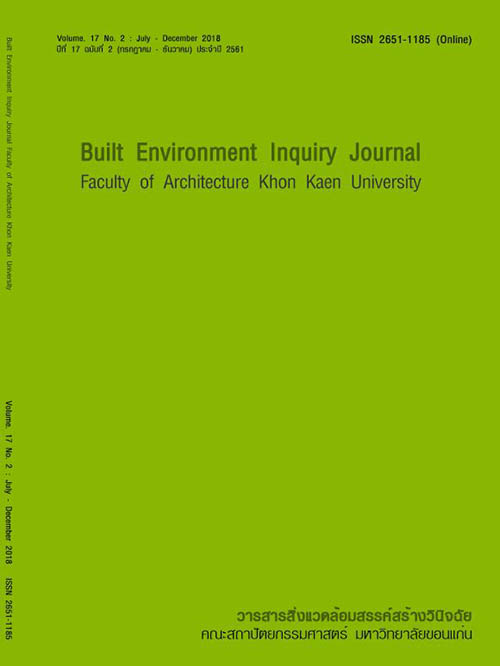ความรู้สึกเป็นสถานที่และการพัฒนาอย่างยั่งยืนของสองชุมชนละแวกบ้านในเมืองเชียงใหม่
Sense of Place and Sustainable Development:
คำสำคัญ:
ชุมชนละแวกบ้าน, เชียงใหม่, ความรู้สึกเป็นสถานที่, การพัฒนาอย่างยั่งยืนบทคัดย่อ
ปัจจัยสำคัญประการหนึ่งสำหรับการพัฒนาชุมชนละแวกบ้านอย่างยั่งยืนได้แก่การที่ประชาชนในท้องถิ่นได้เข้ามามีส่วนร่วมในการกำหนดแนวทางการพัฒนาชุมชนนั้นๆนักวิชาการหลายท่าน (Fisher: 1984;Mumford: 1987,ฯลฯ) ต่างเห็นพ้องต้องกันว่า“ความรู้สึกเป็นเจ้าของ” เป็นสิ่งสำคัญที่จะนำให้ประชาชนในท้องถิ่นเข้ามามีส่วนร่วมในการพัฒนาบทความวิจัยชิ้นนี้ให้ความสนใจที่“ความรู้สึกเป็นสถานที่” ของคนท้องถิ่นในชุมชนละแวกบ้านเนื่องจากเห็นว่าเป็นสำคัญที่ทำให้เกิดความรู้สึกเป็นเจ้าของและทำให้คนท้องถิ่นเข้ามามีส่วนร่วมในการพัฒนาชุมชนละแวกบ้านของตน
บทความนี้เลือกศึกษาชุมชนละแวกบ้านสองแห่งในเมืองเชียงใหม่ต่อจากการศึกษาที่ผ่านมา (Tansukanun and Daungthima, 2017) ชุมชนละแวกบ้านทั้งสองแห่งนี้มีลักษณะที่แตกต่างกันแต่ต่างได้รับความสนใจจากนักท่องเที่ยวเหมือนๆกันละแวกบ้านวัดล่ามช้างอยู่ในเขตกำแพงเมืองเก่าเชียงใหม่และละแวกบ้านนิมมานเหมินท์อยู่ทางตะวันตกนอกเขตกำแพงเมืองเก่าการศึกษาใช้ปัจจัยระบุ“ความรู้สึกเป็นสถานที่” สามประการ (Punter, 1991) ได้แก่กิจกรรม (activities) องค์ประกอบทางกายภาพ (physical attributes) และความหมาย (meanings) นอกจากนี้ยังได้ศึกษาถึงโครงข่ายพื้นที่ทางกายภาพ-สังคม (socio-spatial networks) ของคนในท้องถิ่นเพื่อให้เห็นมิติที่ลึกซึ้งของความหมายที่มีต่อ“ความรู้สีกเป็นสถานที่” ขณะเดียวกันก็แสดงความสัมพันธ์ขององค์ประกอบทั้งสามที่มีต่อกันอย่างชัดเจนขึ้นบทความนี้ชี้ให้เห็นว่าชุมชนละแวกบ้านทางประวัติศาสตร์ที่คนท้องถิ่นมีความสัมพันธ์กันอย่างแนบแน่นรวมทั้งการมีอยู่ของพื้นที่ศักดิ์สิทธิ์ทำให้คนในละแวกบ้านมีความรู้สีกร่วมกันสูงจึงมีศักยภาพสูงในการมีส่วนร่วมในกระบวนการพัฒนาให้เป็นการพัฒนาชุมชนอย่างยั่งยืนต่อไป
เอกสารอ้างอิง
Adams et al., (2016). Sense of Place. retrieved from https://www.thenatureofcities.com/2016/05/26/sense-of-place/.
Alfast Nurit and Fenster Fovi. (2009). “Between the ‘Global’ and the ‘Local’: On Global Locality and Local Globality”. Urban Geography. 30:5, 543-566, DOI: w0.2747/0272-3638.30.5.543.
ASEANUP. (2017). The 37 World Heritage Sites in South East Asia. retrieved 11 May 2018 from https://aseanup.com/world-heritage-sites-in-southeast-asia/.
Ashworth, G.J. (1991). Heritage Planning. The Netherlands. Geo Pers.
Chiang Mai Planner Network. (2010). Chiang Mai Iam: Urban Planning and Design. A report to Thai Health Promo-tion Foundation. June 2010.
Ghoguill, Charles L. (2008). “Developing sustainable Neighbourhoods” Habitat International. 32. P 41-54. www.elsevier.com/locate/habitatint
Farr, Douglas. (2008). Sustainable Urbanism: Urban Design with Nature. U.S.A. John Willey & Sons, Inc.
Durkheim, Emile. (1984). The Division of Labour in Society. Coser, Lewis ed., Halls, W.D. translate. U.K. Translation.
Evans, P. ed. (2002). Livable Cities?: Urban Struggles for Livelihood and Sustainability. Berkley and Los Angeles, California, U.S.A. University of California Press.
Giddens, Anthony. (1995). Modernity and Self-Identity: Self and Society in the Late Modern Age. The Great Britain. Stanford University Press.
Jacobs, Jane. (1961). The Death and Life of Great American Cities. New York. Random House.
Knox, Paul and Pinch, Steven. (2000). Urban Social Geography: An Introduction. Essex, England. Pearson Education Limited.
Kaplan, R. et al. (1998). With People in Mind: Design and Management of Everyday Nature. Washington D.C. Is-land Press.
Kon Jai Ban. (2017). The Report on The Communities Within Chiang Mai City Wall (in Thai). Chiang Mai. The Chiang Mai World Heritage Initiative Project Final Introductory Report to Chiang Mai Provincial Administration Or-ganization.
Massey, Doreen. (2005). For Space. London, Thousand Oaks, New Delhi. Sage Publications.
Massey, Doreen and Jess, Pat eds. (2000). A Place in the World?: Places, Cultures and Globalization. New York. Oxford University Press.
Montgomery, John. (1998). “Making a City: Urbanity, Vitality and Urban Design”.Journal of Urban Design. 3:1, 93-116, DOI: 10.1080/13574809808724418.
Paksukcharern, Khaisri. (2008). “Soi Lad Pra Yad Palang Gyan: Small Public Spaces and Social Spaces for Thai Communities”(in Thai). Urban and Regional Symposium Proceedings on Energy Saving Cities. Faculty of Architec-ture, Chulalongkorn University. November.
Relph, E. (1976). Place and Placelessness. London. Pion Limited.
Tansukanun, Pranom. (2012). “Emerging Thresholds of Sustainable Urbanism: Theory into Practice” (unpublished). The “Deutsch-Thailandische Gesellschaft” symposium by the Humboldt University and Brandeburgische Akademie, Berlin. 20-22 April.
. (2015). “The Dynamism of Old Wooden Houses within Chiang Mai City Wall”. The Fifth Asian Conference on Sustainability, Energy and the Environment 2015 Official Conference Proceedings. IAFORKobe. 11-14 June. p 585-602.
Tansukanun, Pranom and Daungthima, Wittaya. (2012). The Multi-Layered Districts of Chiang Mai City (in Thai). Chiang Mai. Pu-Pae Printing.
. (2017). “A ‘Sense of Place’ and Neighborhoods in Historic Cities: The Case of Chiang Mai, Thailand”. Built Environment Inquiry, Faculty of Architecture, Khon Kaen University. Year 16 vol. 1.
UNESCO. (2017). Monuments, Sites and Cultural Landscape of Chiang Mai, Capital of Lanna. retrieved 21 May 2018from https://whc.unesco.org/en/tentativelists/6003/.
UNESCO. (2017). Sustainable Tourism. retrieved 4 July 2018 from https://www.unesco.org/education/tlsf/mods/theme_c/mod16.html.
United Nation. (2014). Statement by: Commons Action for the United Nations. retrieved 23 May 2018from https://sustainabledevelopment.un.org/content/documents/6783Commons%20Approach%20to%20Sustainable%20Cities%20and%20Human%20Settlements-1.pdf
United Nation. (2015). Transforming our World: The 2030 Agenda for Sustainable Development. retrieved 9 April 2018 from https://sustainabledevelopment.un.org/post2015/transformingourworld/publication.
Wheeler, Stephen M. and Beatley, Timothy. eds. (2009). The Sustainable Urban Development Reader. Second Edi-tion.London. Routledge.
Zakariya, Khalilah, Nor Zalina Harun and Mazlina Mansor. (2015). “Place Meaning of the Historic Square as Tourism Attraction and Community Leisure Space”. Social and Behavioral Sciences. 202. 477-486.
ดาวน์โหลด
เผยแพร่แล้ว
รูปแบบการอ้างอิง
ฉบับ
ประเภทบทความ
สัญญาอนุญาต
ทัศนะและข้อคิดเห็นของบทความที่ปรากฏในวารสารฉบับนี้เป็นของผู้เขียนแต่ละท่าน ไม่ถือว่าเป็นทัศนะและความรับผิดชอบของกองบรรณาธิการ




